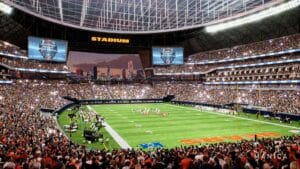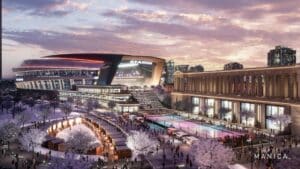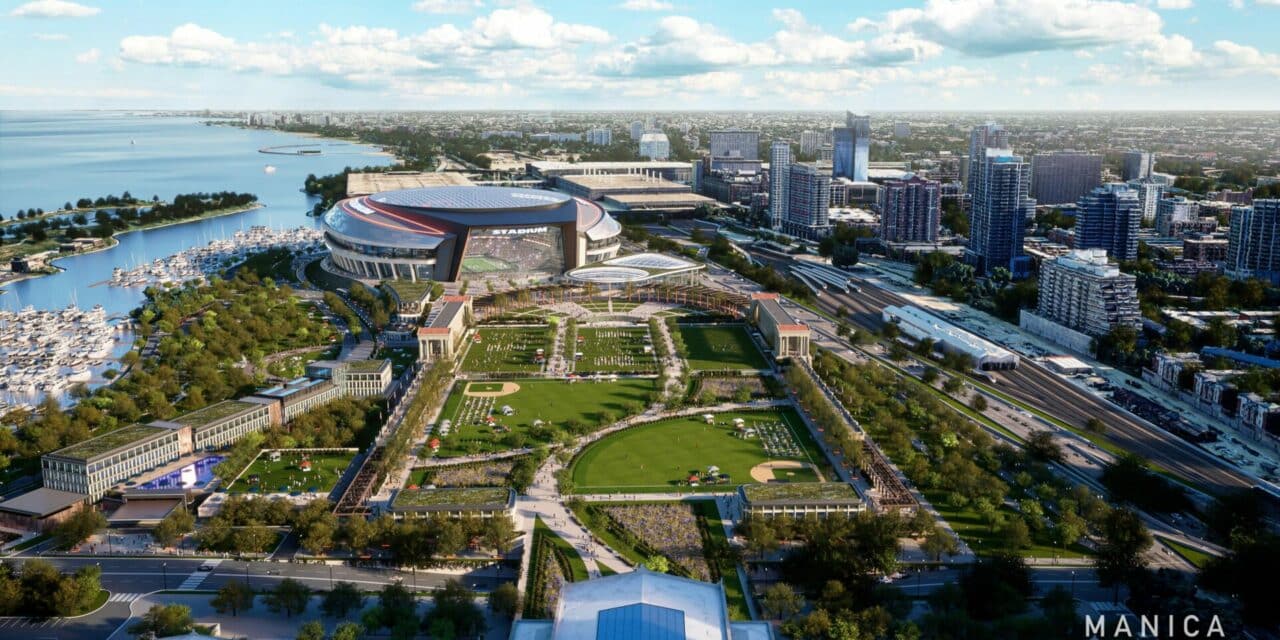BEAR DOWN: The Chicago Bears’ plan to build a new lakefront stadium, shown here in a rendering, extends to converting Soldier Field into public green space. (All images courtesy Chicago Bears)
Century-old master plans part of architect’s research
The Chicago Bears unveiled their master plan on Wednesday to build a new NFL stadium on Chicago’s lakefront and transform their current home, Soldier Field, into a series of sports fields and green space with greater ties to the city’s museum campus.
The Bears, in conjunction with Chicago Mayor Brandon Johnson, announced the project at Soldier Field’s United Club. It’s massive in scope, proposing a $3.2 billion indoor stadium on the site of the Waldron Deck, a parking lot next to the existing facility. The new stadium would be supported by $1.5 billion in infrastructure upgrades, a three-phase project in itself.
David Manica, the Bears’ lead design architect, shared his thoughts on the site with VenuesNow and the inspiration behind the team’s shift from their original plan to build a new stadium at the old Arlington International Racecourse, which sits on 326 acres that the Bears purchased in 2021 for $197 million.
If the financing plan is approved for the lakefront project, a mix of public and private funding, including a $2 billion contribution by the Bears, the project would break ground in summer 2025 and open in 2028.
For Manica Architecture, the renewed focus on the lakefront, the city’s postcard moment, resulted in an effort to develop a new stadium that fits with the iconic Field Museum, Shedd Aquarium and Adler Planetarium, and at the same time, designing a state-of-the-art facility for the Bears with capacity of 65,000, which with an increase in standing room seats, would be slightly bigger than Soldier Field.
It also meant resolving the sticky issue of replacing Soldier Field, a century-old building renovated 20 years ago, a flawed process that ultimately resulted in the building being stripped of its historic landmark status. The new stadium development team, including David Manica, meets weekly with lakefront advocate groups to ensure the project preserves and improves the museum campus.

REAR WINDOW: The new lakefront stadium’s signature feature would be a giant window opening with views to downtown Chicago.
“We were very careful to make sure the building had the spirit of Chicago and was a friendly neighbor to the adjacent museums,” Manica said. “We’re using an architecture that’s both modern, but has traditional elements in it; using colors and materials similar to the Field Museum. We wanted it to have timeless feel, because it’s such an important location on the waterfront and the front door of Chicago.”
In the early stages of design, Manica said the new stadium exterior is a sustainable mix of ceramic stone with glass and recycled metal panel and wood details. From observing initial renderings, the signature feature is the giant panoramic window opening on the new stadium’s north side, providing views to downtown Chicago, Lake Michigan and the additional park space created by knocking down Soldier Field.
There are 360-degree views of the same elements from inside the stadium and a 270-degree outdoor balcony on the upper concourse, which similar to New Nissan Stadium, the Tennessee Titans’ new venue and a Manica project, will provide some of the best views of Chicago. The intent was to capture the city skyline as the backdrop for every event, Manica said.
The new stadium will have much better sightlines, more leg room and greater seat width than Soldier’s Field’s seating bowl shoehorned between the historical columns as part of the past renovation.
The reuse of Soldier Field is a critical part of the project to meet the needs of all Chicagoans and the tens of thousands of visitors annually to the city. In every way, the project team respected the historic structure and how it could be transformed into an asset for the museum campus after the stadium is torn down, he said.
“I’m ecstatic about the master plan for the whole site, maintaining (Soldier Field’s) historic columns and the integrity of the exterior facade, except for the plaza entrance,” Manica said. “There’s a historic Veterans portal entrance we’re maintaining that will be part of the smaller buildings to the northwest of the new stadium, with a hall of fame and team store that will allow that portal to remain intact.”
Manica Architecture’s project research involved spending an extensive amount of time analyzing the 115-year-old master plan by Chicago civic architect Daniel Burnham to beautify and preserve the city’s lakefront, which evolved into the construction of three of the city’s highest-attended museum attractions with the Field, Adler and Shedd buildings, all of which opened from 1921 to 1930.
“What’s more interesting is we studied the (1893) World’s Fair plan for this particular site, which had an incredible amount of building and activity on it,” Manica said. “If you look at that site today, it’s not as active as it could be for the city. One of the things we wanted to do was bring that spirit of (both plans) as an asset for Chicago, to create a better a better connection so people can enjoy it all the time.”

ON ICE: A winter scene tied to the lakefront stadium shows an ice rink on the site of Soldier Field.
The master plan includes the Bears playing at Soldier Field while the new stadium is under construction next door. It’s a tough task, Manica acknowledged. There will be a point of separation from the big plaza fronting the new building, which gives construction crews some breathing room to work without affecting Soldier Field operations.
It’s a complicated equation, but no different than the challenges the Titans have faced with building their new stadium next to existing Nissan Stadium, according to Manica.
In Chicago, the loss of parking by building on the site of the Waldron Deck would be replaced by a new parking structure, with the number of spaces still a fluid process as it relates to the overall costs of the development.
“We’ve been working hard on understanding the staging, marshaling, sequencing and traffic,” he said. “It will work and it’s the best place for the stadium to go, given their other options. This is incredible for the city; this is where the heartbeat of Chicago is, the not out in Arlington Heights. The Bears are completely focused on this site now and that’s where all their energy is going.”
Bears President Kevin Warren is pushing hard to make sure the stadium is open by 2028, Manica said, considering inflation and the escalation in construction costs for a multibillion project. The same was true for the Las Vegas Raiders and Allegiant Stadium, which Manica designed in tandem with HNTB.
Karen Murphy, the Bears’ executive vice president of developing and chief operating officer, said during the press conference that project delays could result in an additional $150 million to $200 million a year to complete the project.
Mortenson, the general contractor that built Allegiant Stadium in 32 months, has been involved in pre-construction services for the Bears stadium.
“We designed and constructed Allegiant Stadium in less time than any other NFL stadium built before, and did it primarily for that reason,” Manica said. “Part of it was to get out of Oakland and into Vegas as soon as possible, but it saved a huge amount of money related to pure inflation. Sometimes, it’s the difference between making or breaking a project.”







